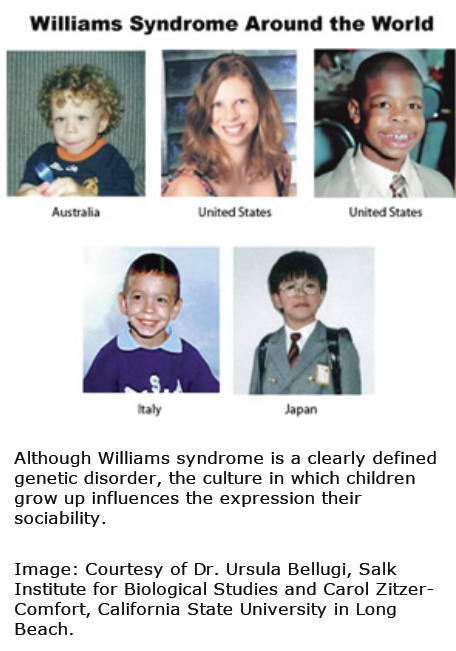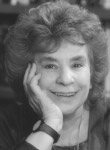NIH awards Salk Institute a Program Project grant to study Williams syndrome
LA JOLLA, CA - A multi-institutional team headed by Ursula Bellugi, professor and director of the Laboratory for Cognitive Neuroscience at the Salk Institute for Biological Studies, has been awarded a Program Project Grant by the National Institute of Child Health and Human Development (NICHD) to link social behavior to its underlying neurobiological and molecular genetic basis using Williams syndrome as a model.
"How the brain processes social information and integrates it with other forms of perception and learning is one of the major frontiers in neuroscience," says Bellugi. "Using Williams syndrome as the basis for a new approach to social neuroscience is exciting and promising, in part because its genetic basis is clearly understood, and it is associated with a very specific pattern of cognitive strengths and weaknesses and some puzzling paradoxes."
Williams syndrome arises from a faulty recombination event during the development of sperm or egg cells. As a result, virtually everyone with
Williams syndrome has exactly the same set of genes missing (25 to 28 genes are missing from one of two copies of chromosome 7). There also are rare cases of individuals who retain one or more genes that most people with the disorder have lost.
To children with Williams syndrome, people are much more comprehensible than inanimate objects. Despite myriad health problems and generally low IQs, they are extremely gregarious, irresistibly drawn to strangers, and insist on making eye contact. The children are confounded by the visual world around them, however: asked to draw a bicycle, they will show all the parts, but strew them randomly across the page. It is this strange mix of mental peaks and valleys that Bellugi and her collaborators hope will allow them to untangle the connections between genes and social behavior.
"Understanding the mechanisms and pathways underlying the organization of human social behavior is important in a wide variety of mental disorders," says Bellugi. "By dissecting Williams syndrome, we hope to gain new insight into other neurodevelopmental disorders such as autism."
The current grant is the latest chapter in a unique and exceptionally successful scientific alliance under the umbrella of a longstanding NICHD-funded Program Project, one of the first of its kind. Led by Bellugi, a team of researchers working in such disparate fields as social cognition, stem cell biology, neuronal architecture and neuroimaging are looking to Williams syndrome to provide clues to some of the mysteries of the genetic basis of social behavior.
Participating researchers:
Williams Syndrome: A Model for Linking Genes, Neural Systems, and Social Phenotype
Project I: Genetics
 This project is led by Dr. Julie Korenberg, with the goal of establishing the genetic architecture of WS in order to determine genetic contributions to human cognition and social behavior. The known genetic basis for WS provides a special foundation for examining the role of specific WS genes in the regulation of social-emotional behaviors.
The project is now using genomewide exon arrays to suggest gene networks perturbed in WS, leading to the hypothesis that the regulation of neuropeptide systems may be involved in WS social behavior. In the program as a whole, we propose novel ways to integrate multiple genetic mechanisms with cognitive, social and brain imaging features.
This project is led by Dr. Julie Korenberg, with the goal of establishing the genetic architecture of WS in order to determine genetic contributions to human cognition and social behavior. The known genetic basis for WS provides a special foundation for examining the role of specific WS genes in the regulation of social-emotional behaviors.
The project is now using genomewide exon arrays to suggest gene networks perturbed in WS, leading to the hypothesis that the regulation of neuropeptide systems may be involved in WS social behavior. In the program as a whole, we propose novel ways to integrate multiple genetic mechanisms with cognitive, social and brain imaging features.
Project II: Human Neurons
 In this project, Dr. Alysson Muotri will be identifying the characteristics of disease neurons in WS, by looking at the teeth from WS individuals. The cells from the teeth are reprogrammed to become brain or nerve cells, which allows us to examine the growth differences between brain cells from individuals with WS and typically-developing individuals. This study could uncover gene expression changes that occur in early development and how they are different in WS. We are forming the cell lines from WS individuals with typical genetic deletions as well as atypical deletions, in order to shed light on the effects of individual genes on phenotype. The cell models represent the early stages of neurodevelopmental disease, and our studies may offer a cellular tool for forming personalized treatments of WS.
In this project, Dr. Alysson Muotri will be identifying the characteristics of disease neurons in WS, by looking at the teeth from WS individuals. The cells from the teeth are reprogrammed to become brain or nerve cells, which allows us to examine the growth differences between brain cells from individuals with WS and typically-developing individuals. This study could uncover gene expression changes that occur in early development and how they are different in WS. We are forming the cell lines from WS individuals with typical genetic deletions as well as atypical deletions, in order to shed light on the effects of individual genes on phenotype. The cell models represent the early stages of neurodevelopmental disease, and our studies may offer a cellular tool for forming personalized treatments of WS.
Project III: Tissue Donation
 Professor Katerina Semendeferi is the leader of this project, which will analyze the brain in WS at the cellular level. Irregularities are suspected to be present in several brain areas in WS and new, cutting-edge techniques will be used to identify their nature and extent. Differences in the size, shape, and molecular make-up of brain cells will be investigated, contributing to new scientific information on brain development and brain organization typical of WS.
This line of research depends exclusively on precious brain tissue donated to research by individuals and their families interested in advancing science and benefiting future generations. Brain donations are treated with utmost respect following careful documentation and analyses. Without this tissue, studies that could lead to the understanding of WS at the cellular level cannot be done. We encourage families to consider becoming donors because by doing so, you are ultimately helping us to unlock some of the mysteries of WS.
(Tissue Donation)
Professor Katerina Semendeferi is the leader of this project, which will analyze the brain in WS at the cellular level. Irregularities are suspected to be present in several brain areas in WS and new, cutting-edge techniques will be used to identify their nature and extent. Differences in the size, shape, and molecular make-up of brain cells will be investigated, contributing to new scientific information on brain development and brain organization typical of WS.
This line of research depends exclusively on precious brain tissue donated to research by individuals and their families interested in advancing science and benefiting future generations. Brain donations are treated with utmost respect following careful documentation and analyses. Without this tissue, studies that could lead to the understanding of WS at the cellular level cannot be done. We encourage families to consider becoming donors because by doing so, you are ultimately helping us to unlock some of the mysteries of WS.
(Tissue Donation)
Project IV: Neuroimaging
 We all know that people with WS have special brains- but how are they special? This project uses advanced brain imaging to literally look inside the heads of people with WS and see how their brains are put together and how they operate. We use MRI to image the structure of WS brains. MRI is painless and safe, but it makes a lot of noise! With the help of some really smart computers, we can measure the size of the different parts of the brain, and even their connections. We also use magnetoencephalography, or MEG for short, to see the reaction of different parts of the brain to faces showing different emotions. MEG is an extremely sensitive detector of the currents that your brain uses for perceiving, thinking and feeling. It is also completely safe, and quiet. From our measurements, we hope to find out more about how the brains of people with WS are special.
We all know that people with WS have special brains- but how are they special? This project uses advanced brain imaging to literally look inside the heads of people with WS and see how their brains are put together and how they operate. We use MRI to image the structure of WS brains. MRI is painless and safe, but it makes a lot of noise! With the help of some really smart computers, we can measure the size of the different parts of the brain, and even their connections. We also use magnetoencephalography, or MEG for short, to see the reaction of different parts of the brain to faces showing different emotions. MEG is an extremely sensitive detector of the currents that your brain uses for perceiving, thinking and feeling. It is also completely safe, and quiet. From our measurements, we hope to find out more about how the brains of people with WS are special.
Project V: Social Phenotype
 This project aims to characterize the sociability of WS, and how it connects all these projects together. More specifically, we are looking at the WS drive for approaching strangers, their strong interest in human faces, as well as their emotional sensitivity. Through the use of ERPs (event-related potentials), we can eavesdrop on the brain to see what activity is occurring during different social stimuli. By looking at the social behavior across levels (gene, brain, behavior), we are gaining invaluable insight into the enigmas of WS, with the ultimate goal of capturing an understanding that will allow us to help individuals with WS live up to their fullest potential.
These exciting studies are not possible without the ongoing support of our valued WS participants and their families. With your help and encouragement, we are unraveling the mysteries of the WS brain, and linking that with genes and behavior. Learning about WS in such a multi-level way is something that has never been done before, and we are thrilled to be embarking on this adventure!
This project aims to characterize the sociability of WS, and how it connects all these projects together. More specifically, we are looking at the WS drive for approaching strangers, their strong interest in human faces, as well as their emotional sensitivity. Through the use of ERPs (event-related potentials), we can eavesdrop on the brain to see what activity is occurring during different social stimuli. By looking at the social behavior across levels (gene, brain, behavior), we are gaining invaluable insight into the enigmas of WS, with the ultimate goal of capturing an understanding that will allow us to help individuals with WS live up to their fullest potential.
These exciting studies are not possible without the ongoing support of our valued WS participants and their families. With your help and encouragement, we are unraveling the mysteries of the WS brain, and linking that with genes and behavior. Learning about WS in such a multi-level way is something that has never been done before, and we are thrilled to be embarking on this adventure!





